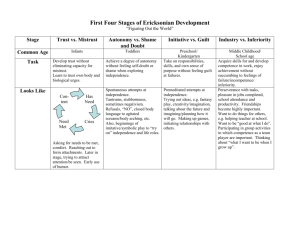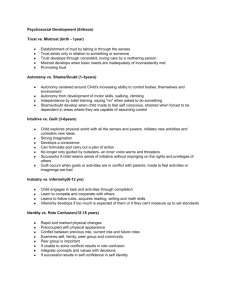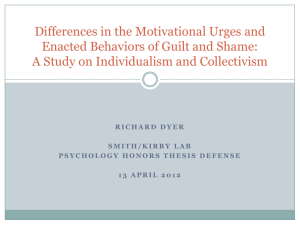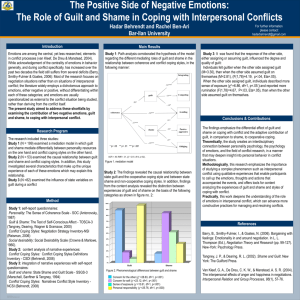Poortinga1
advertisement
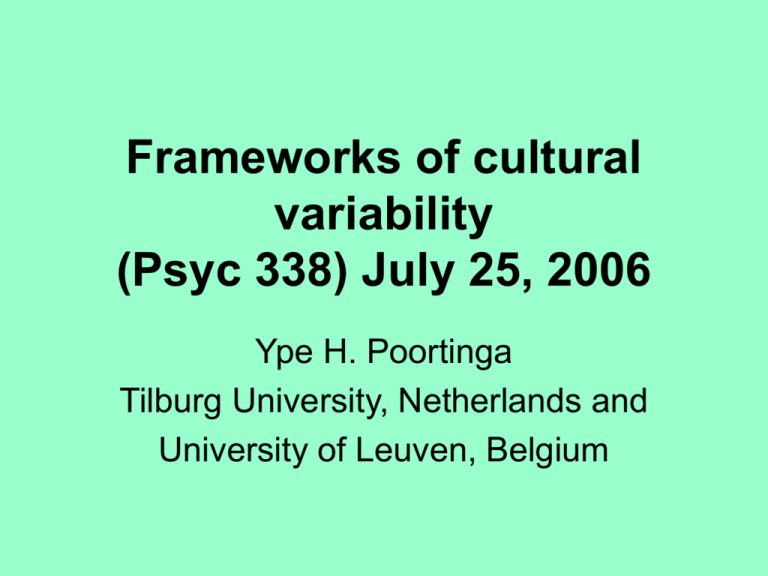
Frameworks of cultural
variability
(Psyc 338) July 25, 2006
Ype H. Poortinga
Tilburg University, Netherlands and
University of Leuven, Belgium
Organization of this presentation
Culture always matters, an example
What is culture? (A psychological approach)
Two dimensions of interpretation of cc differences
A bit of history
An alternative theory: Culture as a set of conventions
Conclusions
Culture ALWAYS matters in human behavior:
An example, the Horizontal-Vertical Illusion
Example: horizontal-vertical illusion (results)
(Segall, Campbell, & Herskovits, 1967)
What do psychologists mean with “culture”?
Culture arises from a faculty (or set of faculties) of the human
species
We learn from experience, we reflect on experience and we
transmit knowledge (including beliefs) to the next generation more
than other species
Culture is the context in which a person lives, including ecocultural
(economic, political) and socio-cultural (values, norms beliefs,
practices) aspects
Behavior-culture relationships are studied as external influences
on the person (antecedent conditions) and as part of the person
(internalized, meaning)
How culture matters: Two theoretical dimensions
1. Relativism vs. universalism (also: cultural vs culture-comparative
approaches)
- Cultural relativism (primacy of culture; context is mediating;
“qualitative”):
“Culture and psyche make each other up”
“There is one mind but many mentalities” (cf. machoism, detachment)
- Ψal universalism (primacy of organism; antecedents; “quantitative”)
“Ψal processes are universal, but manifestations in overt behavior differ”
2. (In)coherence of culture-and-behavior relationship:
- Culture as coherent (system, syndrome)
Geertz’s octopus
- Culture as a set of conventions (i.e., rules about what to do,
what to believe)
Explanations of cc differences ordered in two
dimensions
A bit of history: Perception
Rivers (1901) concluded from a review of the literature and data from
the Torres Strait Islands that “savage and half-civilized” people had a
somewhat better visual acuity than the “normal European” (p. 42)
He also observed among the native population a great attention to
detail and saw this as an impediment to cognitive development: “the
predominant attention of the savage to concrete things around him
may act as an obstacle to higher mental development” (p. 45)
Such a trade-off is known as the "compensation hypothesis" (e.g.,
Deregowski, 1980)
A bit of history: Perception
Biesheuvel (1943) and Ombrédane (1954) suggested that Africans
were more oriented towards the auditory modality and Europeans
towards vision based on, e.g., sense of rhythm and the variety of
languages spoken by unschooled urban Africans, and the tradition of
reading and writing among Europeans
Compensation hypotheses are no longer in fashion, perhaps
because empirical studies found little support (Deregowski, 1980;
Poortinga, 1971), but more likely because there has been change in
the common view about cross-cultural differences
A bit of history: Perception
Differences that have stood up to empirical scrutiny are specific
(limited to precise antecedents and categories) and can be
explained against a background of cultural invariance in
psychological functioning
Examples include susceptibility to visual illusions (Segall et al.,
1967), effects of direction of reading (Chokron & De Agostini, 2000)
and word segmentation
A bit of history: Cognition
Where we infer "culture", 18th century authors tended to infer climate
(e.g., Montesquieu); with a moderate climate as favorable for the
development of "civilization"
A century later evolutionary differences between "us" and the
"primitives" were in fashion (cf. racial differences in IQ; Porteus, 1936)
In the 20th century "culture" became the main focus of analysis
In the 1930s Luria (1971) studied syllogisms with unschooled and
schooled farmers in Central Asia. He concluded that the faculty for
abstract thinking is absent among illiterates; it is a culturally mediated
faculty (Vygotsky)
Later on Scribner (1979) showed that not the Aristotelian principles of
logical reasoning, but the selection of information (own experience, vs
information given in the premises) is the key factor
A bit of history: Cognition
Scribner and Cole (1981) demonstrated with the Vai in Liberia that
not literacy per se, but knowledge learned in western style education
makes the difference
Dasen (1975) showed a gap between performance and competence
for Piagetian tasks of operational thinking among Australian
Aboriginal children
Cole (1996) has followed a domain-oriented approach, studying how
children learnt to use computers
There has been a trend away from "Great Divide" theories, towards
explanation of cc differences in more specific influences
Note: An exception is work by Nisbett and colleagues (e.g., 2001)
who see an East-West distinction between analytic and holistic
thinking, traceable to the ancient Greeks vs Confucius
A bit of history: Personality research
Perhaps the most sweeping generalizations about cc differences
are found in the area of personality research
Benedict (1934) characterized entire cultural populations in terms of
unique configurations, to which most members learn to adapt and
conform; thus the Pueblo Indians were qualified as “Apollonian” and
the Plains Indians as “Dionysian”.
Mead (1928) is best known for her controversial description of the
sex life of adolescent girls on Samoa (Freeman, 1983)
Mead (1935) also described the Tchambuli where the ideal woman
was alleged to be energetic and asserting, while the ideal man
stayed at home and occupied himself with gossip and domestic
tasks
A bit of history: Personality research
Other notions derived from anthropological traditions include "the
authoritarian personality syndrome" and "national character"
Most (or perhaps all??) of these differences are overgeneralizations
reflecting stereotypes and prejudices
Comparative research with personality inventories has shown
invariance of personality dimensions (like the Big Five, or Eysenck's
Giant Three)
A dimension found with the Chinese Personality Assessment
Inventory (CPAI), namely Interpersonal Relatedness, which includes
aspects such as harmony and concern for maintaining face was also
found with European American samples when this inventory was
used (Cheung et al., 2001, 2003; Lin & Church, 2004)
A bit of history: Social psychological dimensions
The weight of cc research has shifted to socio-cultural dimensions,
like individualism-collectivism or independence of the self versus
interdependence of the self
The evidence for such dimensions derives mainly from correlational
studies or quasi-experimental studies in which there is no control on
the independent variable
Question: Has ccp finally identified the major ways in which cultural
populations differ from each other, or will currently popular
dimensions in the future be recognized as over-generalizations?
An alternative: Culture as a set of conventions
Within several areas of cc research, there has been a trend from
more general to more precise (less inclusive) interpretations of cc
differences
There are few cc theories fitting the lower half of the Figure in slide 7
The most important of exception is Michael Cole (1996), who
belongs in the lower left quadrant
There are no theories for the lower right quadrant
What would such a theory look like?
It would conceive of culture as an enormous array of only loosely
interconnected cultural practices, or conventions
Conventions are partially arbitrary culturally agreed upon ways of
doing things and believing things, as well as norms about what to
think and believe (Berry et al. 2002, Ch 12)
Conclusions
This lecture has given examples of previous interpretations of cc
differences in behavior repertoire that did not stand the test of time
The examples were taken from various domains of psychological
research
The gist of the argument is not that there are no "general" cultural
factors
However, such factors are not to be inferred too lightly
Additional materials
The following slides provide a similar argument as given above for
domains of cross-cultural research not covered in the lecture
A bit of history: Language
Whorf (1956) argued that:
"the background linguistic system (in other words, the grammar) of
each language is not merely a reproducing instrument for voicing
ideas but rather is itself a shaper of ideas" (p. 212) , and
"[w]e dissect nature along lines laid down by our native language"
(p. 213).
Decisive research requires a natural (physical) referent
Much research has been conducted with color words: Is the
spectrum split up the same way across languages?
A bit of history: Language
Another domain is spatial orientation
Levinson and colleagues distinguish ego-referenced orientation ("on
my right side"), geocentric orientation ("on the East side"), and
intrinsic orientation (location with reference to another object: "the
duck is behind the boat")
Dasen and colleagues (e.g., 1999) found on Bali and in India that
encoding to some extent was task dependent
A bit of history: Language
Bowerman (1996) describes how prepositions such as “in” or “on” in
English often are not translation equivalent. Thus, in Finnish the
handle is in (rather than on) the pan
In Korean there is a distinction between the verbs “kkita” referring to
objects that fit tightly into each other (putting the cap on a pen) and
“nehta” for loosely fitting relations (putting books in a bag) that has
no direct match in English (Bowerman & Choi, 2003)
In habituation experiments McDonough et al (2001) found that both
Korean and English children as young nine months showed evidence
of making this distinction
A bit of history: Language
Hespos and Spelke (2004) obtained similar results with five months
old infants in both Korean and English speaking environments, i.e.,
long before the onset of speech. Apparently, sensitivity to a
conceptual distinction available for infants but not marked by their
native language becomes reduced.
Does ego-referenced orientation imply "profound linguistic effects on
cognition" (Majid, et al., 2004, p. 113)?
A bit of history: Emotional experiences
"One can assume that there exist words ('emotion words') that
dictate the way things are seen; or one can assume that there exist
things ('emotions') that are given names and thus have words
assigned to them" (Frijda et al., 1995)
Culture-specific emotions have been inferred from emotion terms for
which there is no translation equivalent, e.g., "Schadenfreude" "song"
(justifiable anger among the Ifaluk, Lutz, 1988), or "liget" (anger
associated with head hunting among the Ilongots, Rosaldo, 1980)
Others claim that (basic) emotions are invariant across cultures; e.g.,
Ekman (1973) distinguished 7 basic emotions on the basis of facial
muscular patterns
Cc differences result mainly from variations in "display rules"
A bit of history: Emotional experiences
Rarámuri Indians in Mexico who use one word for guilt and shame
were shown to differentiate between shame and guilt components
Breugelmans and Poortinga (2005) first elicited local emotion
scenarios among Rarámuri and among rural Javanese. Ratings by
Dutch and Indonesian students were used to select shame-eliciting
and guilt-eliciting scenarios from both regions
In the crucial study other Rarámuri respondents rated these scenarios
on emotion components that previously had been found to
differentiate between shame and guilt in a student sample composed
of Dutch/Belgian, Mexican and Indonesian students
For most components, the pattern of differentiation found for the
Rarámuri matched that of the students
With a rural Javanese sample similar results were obtained as for
both the Rarámuri and the international student sample
.30
angry with others
Internal - External
.20
explaining
sweating
center of attention
feeling hot
trying to forget
.10
apologizing
done damage
.00
guilt
being responsible
moral norm
-.10
-.20
smiling
hiding
evading looks
punishing self
others disapprove
bad person
angry with self
ruminating
harms reputation
-.30
-.40
-.30
-.20
-.10
blushing
shame
.00
.10
Guilt - Shame
.20
.30
.40
.30
.20
explaining
smiling
Internal - External
apologizing
.10
“student guilt”
done damage
.00
bad person
moral norm
others disapprove
-.10 being responsible
punishing self
harms reputation
deserving punishment
confused
-.20
-.30
-.40
-.30
-.20
-.10
sweating
shame
center of attention
hiding
feeling hot
weak limbs
.00
.10
Guilt - Shame
.20
.30
.40





